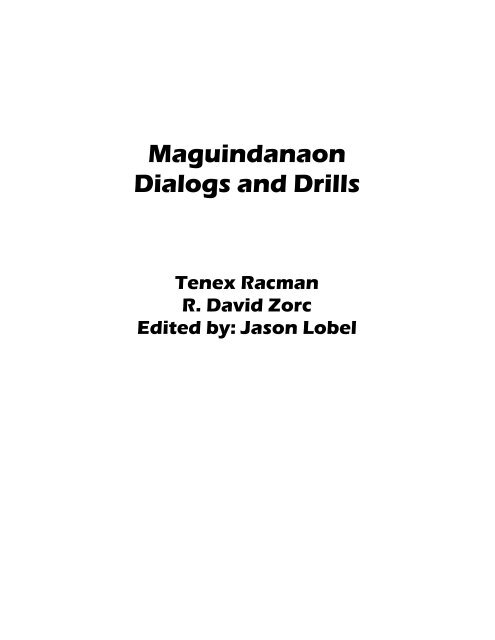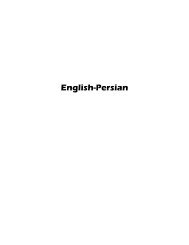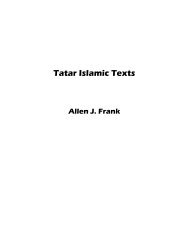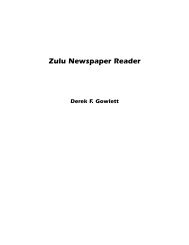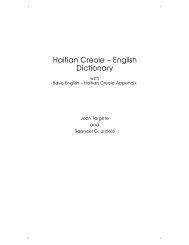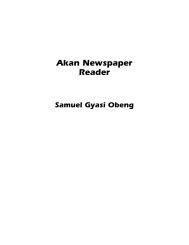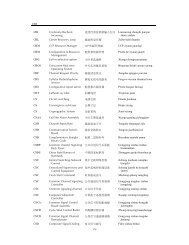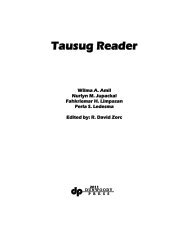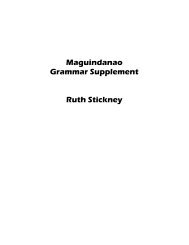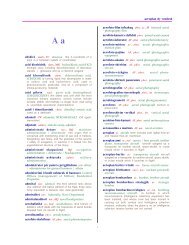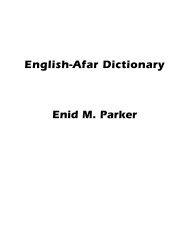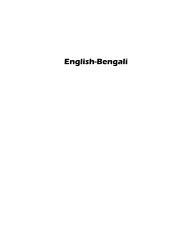Maguindanaon Dialogs and Drills - Dunwoody Press
Maguindanaon Dialogs and Drills - Dunwoody Press
Maguindanaon Dialogs and Drills - Dunwoody Press
You also want an ePaper? Increase the reach of your titles
YUMPU automatically turns print PDFs into web optimized ePapers that Google loves.
<strong>Maguindanaon</strong><br />
<strong>Dialogs</strong> <strong>and</strong> <strong>Drills</strong><br />
Tenex Racman<br />
R. David Zorc<br />
Edited by: Jason Lobel
<strong>Maguindanaon</strong><br />
<strong>Dialogs</strong> <strong>and</strong> <strong>Drills</strong><br />
Tenex Racman<br />
R. David Zorc<br />
Edited by: Jason Lobel<br />
<br />
2009
<strong>Maguindanaon</strong> <strong>Dialogs</strong> <strong>and</strong> <strong>Drills</strong><br />
Copyright © 2009 by McNeil Technologies, Inc.<br />
All rights reserved.<br />
No part of this work may be reproduced or transmitted in any form or by any<br />
means, electronic or mechanical, including photocopying <strong>and</strong> recording, or by any<br />
information storage <strong>and</strong> retrieval system, without prior written permission from the<br />
copyright owner.<br />
All inquiries should be directed to:<br />
<strong>Dunwoody</strong> <strong>Press</strong><br />
6525 Belcrest Rd., Suite 460<br />
Hyattsville, MD 20782, U.S.A.<br />
ISBN: 978-1-931546-62-1<br />
Library of Congress Control Number: 2009928904<br />
Printed <strong>and</strong> bound in the United States of America
Table of Contents<br />
Publisher’s Preface i<br />
Preface iii<br />
Acknowledgement vii<br />
Bibliography of <strong>Maguindanaon</strong> ix<br />
<strong>Dialogs</strong><br />
Dialog 1. Greetings (Salam) ..................................................................... 2<br />
Dialog 2. Making Acquaintances (Kapegkilalay) ..................................... 6<br />
Dialog 3. Cooking (Kabpagalugan) ........................................................ 12<br />
Dialog 4. Shopping at the Market (Sia Sa Padian) ................................ 16<br />
Dialog 5. Planting Crops (Kabpamula) .................................................. 18<br />
Dialog 6. Wedding Preparations (Kapegkaluma, Kapegkalilang,<br />
Kabpeligaw, Kabpanalanggunia) ............................................ 22<br />
Dialog 7. Fishing (Kabpanginseda) ........................................................ 36<br />
Dialog 8. Looking for Relatives (Kapedsangul/Kabpanuntul<br />
Sa Pagali) ................................................................................ 46<br />
Dialog 9. Going to School (Kabpangagi) ............................................... 56<br />
Dialog 10. Family Relationships (Kabpagalia/Kabpagasala/Kadsuled) ... 64<br />
Dialog 11. Taking a Trip (Kabpelalakaw/Kabpageda) ............................. 70<br />
Dialog 12. Telling the Time (Uras) .......................................................... 98<br />
Dialog 13. Celebrations (K<strong>and</strong>uli) .......................................................... 104<br />
Dialog 14. Talking About the Weather (Egkambetad Na Gay) ............. 110<br />
Dialog 15. Sports (Kapendalamet/Kapembula) ...................................... 118<br />
Dialog 16. Government <strong>and</strong> Politics (Kapebpulitika Sa Gubilnu) ......... 124<br />
Dialog 17. Employment (Galebekan) ..................................................... 138<br />
Dialog 18. Sending Mail (Pus-Upis, Papebpapaitan/Ebpagulugan<br />
Sa Sulat) ................................................................................ 144<br />
Dialog 19. Sending Messages (Imil/Tiks Misids) .................................. 148<br />
Dialog 20. Courtship (Kapendiligawa/Kabpanganakan) ........................ 152<br />
Dialog 21. Rumors (Kap<strong>and</strong>alakita) ....................................................... 164<br />
Dialog 22. Telling Jokes (Damangias/Kadtatawan) .............................. 170<br />
<strong>Drills</strong><br />
Drill 1: Topic Position Slots ................................................................. 175<br />
Drill 2: Possessive (Associate) Position Slots ....................................... 178<br />
Drill 3: Referent (Locative, Beneficiary) Position Slots ....................... 181<br />
Drill 4: Questions <strong>and</strong> Idioms of Time ................................................. 184<br />
Drill 5: Spatial Relators <strong>and</strong> Locatives. ................................................ 187<br />
Drill 6: Aspect <strong>and</strong> Time in Verbs Using Time Relators ...................... 189<br />
Drill 7: Use of Negatives Dala, Dili ..................................................... 201<br />
Drill 8: Use of Other Particles manga, a, aden, wala! .......................... 204<br />
Drill 9: Use of Simple Tenses in Object Focuses ................................. 208
Drill 10: Idioms of Three Different Object Focuses (Future Tense) ....... 210<br />
Drill 11: Aspect in Each of the Three Object Focus ............................... 214<br />
Drill 12: Stative Verbs (of various types) ............................................... 223<br />
Drill 13: Causative Verbs pa of Various Types ...................................... 226<br />
Drill 14: Use of discourse Particles den – pan, besen, ba ....................... 229<br />
Drill 15: Intensive Adjectives & Statements of Surprise ........................ 232<br />
Drill 16: Additional Verb Infixes <strong>and</strong> Affixes ........................................ 235<br />
Drill 17: Negatives in the Objects (Oblique 1-3) Focuses ...................... 239<br />
Drill 18: Use of Distributive mig - Verbs ............................................... 242<br />
Drill 19: Use of dala in Oblique Focus with Past Tense Meaning .......... 245<br />
Drill 20: Use of Modals <strong>and</strong> Verb Determiners (Idioms) ....................... 247<br />
Drill 21: The Idiomatic Use of Other Focus- .......................................... 250<br />
Drill 22: Use of su <strong>and</strong> i. ......................................................................... 253
PUBLISHER'S PREFACE<br />
<strong>Maguindanaon</strong> <strong>Dialogs</strong> <strong>and</strong> <strong>Drills</strong> is the first in a series of four textbooks<br />
on the languages of the Philippines. The other three in the series are for<br />
Maranao, Pangasnian, <strong>and</strong> Yakan. The books are intended for learners who<br />
have had basic instuction in the language, or who have a firm<br />
underst<strong>and</strong>ing of another Philippine language. The purpose of this series is<br />
to expose students to the spoken <strong>and</strong> written language through dilaogs<br />
between native speakers, <strong>and</strong> to reinforce knowledge of grammar <strong>and</strong><br />
syntax through drills presented here as framed sentences.<br />
The Publisher wishes to express sincerest thanks <strong>and</strong> deep appreciation to<br />
Dr. R. David Zorc who suggested this series, conducted two fruitful<br />
seminars in Manila with the particpants, <strong>and</strong> who guided the initial drafts to<br />
completion. Dr. Zorc's knowledge of linguistics, <strong>and</strong> more importantly, his<br />
unique ability to explain complicated grammatical concepts to nonlinguists,<br />
is unmatched. His forty-plus years of groundbreaking work in the<br />
languages of the Philippines, not to mention the languages of Africa <strong>and</strong><br />
Eurasia, make him one of the foremost linguists of his or any generation.<br />
The Publsiher also wishes to acknowledge Jason Lobel's contribution to<br />
this book. Mr. Lobel, working with colleagues in Maguindanao, carefully<br />
edited <strong>and</strong> enhanced the text <strong>and</strong> the recordings, thus making this<br />
publication possible.<br />
As always, the Publisher welcomes any comments <strong>and</strong> suggestions to<br />
improve this book.<br />
The Publisher<br />
<strong>Dunwoody</strong> <strong>Press</strong><br />
i
PREFACE<br />
This book contains 22 dialogs <strong>and</strong> 22 drills intended for an intermediate<br />
student of <strong>Maguindanaon</strong>, or a newcomer to <strong>Maguindanaon</strong> but with<br />
knowledge of another Philippine language. The purpose is to give students<br />
additional expose to written <strong>and</strong> spoken material in the language through<br />
controlled conversations <strong>and</strong> tailored exercises.<br />
<strong>Maguindanaon</strong>: Alphabet <strong>and</strong> Phonology<br />
There are 21 letters in the native <strong>Maguindanaon</strong> alphabet, 17 consonants <strong>and</strong><br />
4 vowels. The consonants “j” <strong>and</strong> “z” are seldom used in this book, because<br />
these are mostly used in unassimilated Arabic borrowings. Some<br />
<strong>Maguindanaon</strong> writers do not follow the spelling of the four cardinal vowels,<br />
the “u” is usually pronounced or spelled as “o”, whereas “i” always has the<br />
value of [i] ("ee") in pronunciation, but is also spelled as “e.” Meanwhile, in<br />
this book, the “e” always represents the pepet or schwa sound, <strong>and</strong> never the<br />
“soft e.” <strong>Maguindanaon</strong> does not have a hard “i” or a soft “e”. The letters “c”,<br />
“f”, “o”, “q”, “v” <strong>and</strong> “x” are not used in the <strong>Maguindanaon</strong> alphabet.<br />
There are also some complications as to the spelling of the semivowels “w”<br />
<strong>and</strong> “y”. “W” is also be spelled as “u,” as in the word “kwa” or “kua” 'get.'<br />
“Y” can likewise be spelled as “i”, as in “kyug” or “kiug” 'want.' But in a<br />
recent study (Skoropinski), the CCV patterns contraindicate the use of “w”<br />
<strong>and</strong> “y” as vowels, therefore the “w” <strong>and</strong> “y” position in most instances<br />
should be the semivowels for “u” <strong>and</strong> “i” respectively.<br />
The following is a list of the letters of the <strong>Maguindanaon</strong> alphabet as used<br />
in this book. Each letter is followed by its phonetic values (in IPA linguistic<br />
symbols, when necessary):<br />
Consonants<br />
b b as in banggala 'clothes, apparel'<br />
d d as in dalig 'root'<br />
g g as in gamut 'pain reliever, drugs'<br />
h h as in halal 'any food allowed in Islam'<br />
j j as in jihad 'pleasing someone in an Islamic way'<br />
k k as in kaluma 'spouse, husb<strong>and</strong>, wife'<br />
l l as in lampay 'plate'<br />
m m as in malung 'blanket'<br />
n n as in niug 'coconut'<br />
ng ŋ as in ngali 'mouth'<br />
iii
p p as in papanuk 'bird'<br />
r r as in riba 'usury'<br />
s s as in sagkung 'echo'<br />
t t as in talumpa 'shoes'<br />
w w as in wata 'child;' rarely used; usually spelled with u<br />
y y as in yug 'saliva;' rarely used; usually spelled with i<br />
z z as in Zalika [female name], Zulkaida [month in lunar<br />
calendar]<br />
Vowels<br />
a a as in aden 'there is'<br />
e<br />
ǝ<br />
as in ebpamasa 'buying'<br />
i i as in ibpabagilay 'be shown,' ibpagidsa 'asking'<br />
u u as in umbal 'do, make, build'<br />
<strong>Maguindanaon</strong>: The People <strong>and</strong> Their Language<br />
The <strong>Maguindanaon</strong> are known as the people of the flood plain, located<br />
along the Rio Gr<strong>and</strong>e de Mindanao, which is the longest <strong>and</strong> widest river in<br />
Mindanao, <strong>and</strong> which is both a travel route <strong>and</strong> a source of livelihood.<br />
Farming <strong>and</strong> fishing are two of the major means of making a living for the<br />
<strong>Maguindanaon</strong>s.<br />
<strong>Maguindanaon</strong> has 3 major dialects: Taw sa ilud, Taw sa laya, <strong>and</strong><br />
Biwangen. The Taw sa ilud are the people from the lower part of the<br />
Pulangi River where the water flows. These are the City of Cotabato,<br />
municipalities of Sultan Kudarat, Parang, Datu Odin Sinsuat, Upi, North<br />
Upi, Kabuntalan, Datu Piang, Datu Unsay, Sharief Aguak, Ampatuan,<br />
Mamasapano, Guindulungan, Sultan sa Barongis, Pagalungan, Pagagawan,<br />
Talitay <strong>and</strong> Talayan. From the province of North Cotabato, the<br />
municipalities of Aleosan, Banisilan, Carmen, Pikit, Midsayap, Kabacan,<br />
Matalam, Mlang. The speech of the municipalities of Pikit, Matalam,<br />
Pagalungan <strong>and</strong> Pagagawan differs in pronunciation <strong>and</strong> intonation from<br />
the Taw sa ilud dialect, but is similar in vocabulary.<br />
The Taw sa laya are those people residing in the upriver part of the Pulangi<br />
River. This includes the municipalities of Buluan, Paglas, Salipada K.<br />
Pendatun, <strong>and</strong> Paglat, all in the province of Maguindanao, <strong>and</strong> Tulunan in<br />
the province of North Cotabato; the municipalities of Esperanza,<br />
Laguilayan, Isulan, Ninoy Aquino, Tacurong, Pres. Quirino, Columbio <strong>and</strong><br />
Lutayan, all in the province of Sultan Kudarat; the municipalities of Sto.<br />
Nino, Surallah, Norala, Banga, Lake Sebu, Koronadal, Tantangan,<br />
Polomolok, <strong>and</strong> Tupi, all in the province of South Cotabato as well as some<br />
iv
other parts of Davao City, Davao Del Sur, Davao Del Norte, Davao<br />
Oriental <strong>and</strong> Bukidnon.<br />
The Biwangen area comprises the areas of General Santos City, Sarangani<br />
Province, the coastal municipalities of Sultan Kudarat: Palimbang,<br />
Kalamansig <strong>and</strong> Lebak; the coastal municipalities in the Province of<br />
Zamboanga Del Sur, some municipalities in Zamboanga Del Norte <strong>and</strong> the<br />
City of Pagadian.<br />
Words used in this book are mostly common to all three dialects, whether<br />
from Taw sa ilud, Taw sa laya, or Biwangen. There are also some minor<br />
subdialects in the Taw sa ilud areas, such as in the municipalities of Pikit,<br />
Pagalungan, Pagagawan, <strong>and</strong> Matalam. The municipalities around Talayan<br />
are distinct in their pronunciation <strong>and</strong> vocabulary, for example ‘cat’, which<br />
they call “sika” instead of “bedung” or “puting”. In the case of Taw sa laya,<br />
there is the Isulanen dialect. There are also some differences in vocabulary,<br />
but the basic vocabulary of <strong>Maguindanaon</strong> is generally understood, whether<br />
Taw sa ilud, Taw sa laya <strong>and</strong> Biwangen.<br />
User's Guide<br />
This book contains dialogs <strong>and</strong> drills intended for an intermediate student of<br />
<strong>Maguindanaon</strong> or one transferring to the language with a firm knowledge of<br />
another Philippine language. There is a broad array of dialog topics including<br />
greetings, cooking, planting crops, shopping, the weather, sports, <strong>and</strong> telling<br />
jokes. The drills, presented as framed sentences, are intended to reinforce<br />
one's underst<strong>and</strong>ing of basic <strong>Maguindanaon</strong> grammar <strong>and</strong> syntax. Some of<br />
the drill topics include position slots, spatial relators <strong>and</strong> locatives, stative<br />
verbs, <strong>and</strong> intensive adjectives <strong>and</strong> statements of surprise.<br />
v
The book is divided into two sections: dialogs <strong>and</strong> drills. Ideally, one would<br />
first work through all of the dialogs <strong>and</strong> then the drills. Some students,<br />
however, may choose to use one section or the other depending on their<br />
specific learning needs, for example, the dialogs for translation practice, the<br />
drills for grammar practice.<br />
Using the <strong>Dialogs</strong><br />
To use this book effectively it is suggested that you first listen to the entire<br />
dialog once through to catch intonation patterns <strong>and</strong> words with which you<br />
are familiar. Then, listen to each sentence one-by-one, stop the recording,<br />
<strong>and</strong> repeat the sentence aloud.<br />
After listening to the dialog you should translate the text into English. A<br />
model translation is provided on the facing page of each dialog against<br />
which one can compare his or her translation.<br />
Using the <strong>Drills</strong><br />
The drills are composed of framed sentences with particular frames or slots<br />
to reinforce vocabulary <strong>and</strong> grammar patterns. Listen to the starter<br />
sentence, then repeat the sentence with the vocabulary items under the<br />
sentence, one at a time. Next, translate the sentence to English <strong>and</strong> compare<br />
your translation to the model at the right.<br />
vi
Acknowledgements<br />
Finishing this work without acknowledging the people who have<br />
contributed to its completion would be unconscionable. They are the ones<br />
responsible for the initiation of the project <strong>and</strong> for the encouragement to<br />
work on it. This book could not have been completed without them:<br />
To Dr. R. David Zorc, who I fondly call “Kaka David”, who helped us out<br />
from the very conception of this book. This universal man was able to unite<br />
Muslims <strong>and</strong> Christians in one room with representatives from different<br />
Filipino tribal groups: <strong>Maguindanaon</strong>, Maranao, Yakan, <strong>and</strong> Pangasinan.<br />
During the seminar he sponsored for us, he always reminded us that if<br />
someone is in need of help while working on the book, “I may be halfway<br />
around the world, but I’m only an email away from you.” He was always<br />
there whenever we submitted our work, <strong>and</strong> almost immediately gave us<br />
feedback reports with suggestions <strong>and</strong> recommendations.<br />
He guided us on the formation of the words of the <strong>Maguindanaon</strong>, especially<br />
on prefixation, infixation, <strong>and</strong> suffixation. Although the use of the “um” <strong>and</strong><br />
“mag” verbs is very hard to distinguish, he did a good job of explaining how<br />
the rules worked. In just a few days he could speak <strong>Maguindanaon</strong> well, <strong>and</strong><br />
could teach us native speakers about its usage <strong>and</strong> grammar. He is a true<br />
linguist, as well as being a great motivator <strong>and</strong> group leader.<br />
"Kaka David" is an American in appearance, but a Filipino in heart <strong>and</strong><br />
deed. After only a few days of talking with him, he had shown himself to<br />
be the true image of an American with a golden heart when it comes to<br />
depressed communities like the Bangsamoro.<br />
He never got angry whenever there were lapses in completing the tasks that<br />
were assigned to us. He always mentioned if someone got upset with him,<br />
“I did not intentionally say it. Pardon me if I said something that hurt you.”<br />
He was saying this because he well underst<strong>and</strong>s the culture of Filipinos,<br />
<strong>and</strong> especially the Bangsamoro, not to hurt someone in word or deed.<br />
He gave us his room key whenever it was time for us to pray. He always<br />
reminded us that “if anyone needs to pray, the key is with me, <strong>and</strong> just ask<br />
if you need to use the bathroom.” He gave everyone a “pasalubong” gift<br />
when he came from the United States to follow up on the project, never<br />
forgetting the Filipino custom of giving someone a gift when you come<br />
from a faraway place, or you haven't seen someone for a long time.<br />
To Sir Mel Deatherage, a great English editor. I learned so much from him<br />
in our day-to-day exchanges <strong>and</strong> pleasantries in e-mails.<br />
vii
To Sir Tom Creamer, a very generous boss, who joined us in the seminar <strong>and</strong><br />
helped us with his very interesting topics, making many suggestions<br />
concerning the dialogs. These were very helpful in the process of putting the<br />
dialogs together. He is a man that I describe as “Maamo”: sweet, accessible,<br />
approachable, humble in his dealings with his subordinates, fluent in talking,<br />
<strong>and</strong> underst<strong>and</strong>ing whenever anybody had a problem. He even granted us a<br />
more flexible timetable for the deadline for final submissions.<br />
To my Ama <strong>and</strong> Ina (Mother <strong>and</strong> Father) for their untiring support from my<br />
childhood until now. They are my greatest mentors. They are the greatest<br />
parents, who molded us not to quarrel with each other. They guided us<br />
towards the right path. To my brothers, Nords, Dhelipov, Harbe, Taskie,<br />
Jacob, Megro; <strong>and</strong> my sisters, Fatima <strong>and</strong> Deng. They have always been by<br />
my side whenever there have been problems, by comforting me or by<br />
helping to solve my problems. I also wish to thank Sanurin S<strong>and</strong>anjan who<br />
helped with the initial draft.<br />
Most especially to Allahu Taalla for making my mind, body, <strong>and</strong> soul<br />
active, <strong>and</strong> for giving me the strength to finish this work.<br />
viii<br />
Tenex Racman
Bibliography of <strong>Maguindanaon</strong><br />
Albas, Pablo Y. 1964. A contrastive analysis of English <strong>and</strong> Magindanao<br />
verbs. Unpublished MA thesis, CPU.<br />
Allison, E. Joe. 1974. Proto Danao: A Comparative Study of Maranao,<br />
Maguindanao, <strong>and</strong> Iranon. M.A. dissetation, University of Texas<br />
Arlington.<br />
—1979. Ibid., Papers in Philippine Linguistics, No. 10. Pacific Linguistics<br />
A.55:53-112. Canberra: ANU.<br />
Bakuludan, Samier M., Munap H. Hairulla, Ermina K. Mariano. 1996.<br />
Annotated bibliography: <strong>Maguindanaon</strong>, Tausug, Yakan studies.<br />
Diliman, Quezon City: University of the Philippines, Center for<br />
Integrative <strong>and</strong> Development Studies, Mindanao Studies Program. [57<br />
p. : ill. ; 24 cm.]<br />
Eck, Jerome (Jerry). 1972. "Sketch of Magindanao phonology." Nasuli,<br />
Malaybalay, Bukidnon: SIL. 45 lvs.<br />
— 1974. "Magindanao penultimate vowels."<br />
Fleischman, Eric. 1980. "Magindanaon verbal inflection." Nasuli,<br />
Malaybalay, Bukidnon: SIL. 21 lvs.<br />
—1980. "Phonemics <strong>and</strong> morphophonemics of Maguindanao." Nasuli,<br />
Malaybalay, Bukidnon: SIL. 19 lvs.<br />
—1981. "The decline of datuship in the Iranun sultanate of Linek."<br />
—1981. The Danao languages: Magindanao, Iranun, Maranao, <strong>and</strong> Illanun.<br />
Philippine Journal of Linguistics 12.1:57-77.<br />
—Nasrullah Glang, Makakena Solaiman, Hadji Abdullah Ayub, <strong>and</strong> Faisal<br />
Daud, comps. 1981. Vocabulary: <strong>Maguindanaon</strong>-Pilipino-English.<br />
Manila: SIL. 340 pp.<br />
—1986. "<strong>Maguindanaon</strong> verbal inflection."<br />
Juanmartí, Jacinto. 1892. Breve Vocabulario en Castellano, Moro-<br />
Maguindanao y Malayo. Real 34. Manila: Imprenta 'Amigos del Pais.'<br />
Lee, Ernest W. 1962. "On non-syllabic high vocoids in Maguindanao."<br />
—1964. "Maguindanao /l/."<br />
—1964. "Non-focus verbs in Maguindanao."<br />
Maceda, Jose Montserrat. 1963. "The Music of the Magindanao in the<br />
Philippines." Unpublished PhD dissertation, UCLA. 2 vols.<br />
Moe, Ronald. 1986. "How to find verb roots."<br />
Porter, Ralph Stribling. 1903. A Primer <strong>and</strong> Vocabulary of the Moro Dialect<br />
(Magindanao). Washington, DC: US Government Printing Office. 77 pp.<br />
(Bureau of Insular Affairs, War Department Pamphlet 209).<br />
Skoropinski, D. B. 2003. "Interpretation of High Vocoids in<br />
Magindanaon." «photocopy of work in progress, not for distribution»<br />
ix
Smith, Cap Cornelius C. 1906. "A grammar of the Magindanao tongue." In<br />
Gramatica de la Lengua de Maguindanao Segun se Habla en el Centro<br />
y en la Costa Sur de la Isla de Mindanao, by Jacinto Juanmarti.<br />
Washington, DC: US Government Printing Office.<br />
Sullivan, Robert E. 1986. A <strong>Maguindanaon</strong> dictionary : <strong>Maguindanaon</strong>-<br />
English, English-<strong>Maguindanaon</strong>. Cotabato City (Philippines): Notre<br />
Dame University, Institute of Cotabato Cultures. [545 pages; 28cm;<br />
ISBN: 9711290006]<br />
Yamada, 1964-1975. "Unpublished MS of 513-item vocabulary ((1962)<br />
Tsuchida) of Isnag (2 dialects), Ibanag (2 dialects), Kalinga (2<br />
dialects), Gaddang, Ilokano, Kapampangan, Bikol (2 dialects),<br />
Koyonen, Aklanon (2 dialects), Ilonggo (2 dialects), Kinaray-a, Waray,<br />
Maranaw, Magindanaw, Manobo (Tagabawa), Tausug, <strong>and</strong> Samal."<br />
x
<strong>Dialogs</strong>
<strong>Maguindanaon</strong> <strong>Dialogs</strong><br />
<strong>Maguindanaon</strong><br />
Dialog 1. Greetings (Salam)<br />
1: Asalamu alaikum!<br />
2: Alaikumi salam!<br />
1: Ngin pan i lemawan sa nia ba a salam?<br />
2: Su laki bu na dala lemawan lun sia sa lekitanu a manga Muslim,<br />
ugayd na mamagidsan bun tanan i salam. Apia ngin i salam<br />
nengka na egkasabutan nu Kadnan tanan.<br />
1: Panun i kaped a nan a aden edsiap-siapan nin kanu gay i<br />
kapedsalam sa taw?<br />
2: Ya nengka pedtalun a nan na: “mapia mapita,” “mapia maudtu,”<br />
“mapia malulum,” enggu “mapia magabi.”<br />
1: Uway namba, dili ba i nia egkapakay ipedsalam?<br />
2: Egkapakay sa apia entayn, ugayd sa agama Islam na “Asalamu<br />
Alaikum.”<br />
1: Di mapakay sa semalam aku sa apia entayn?<br />
2: Egkapakay ugayd na ya muskila na su di kena Muslim. Dili<br />
makatuntay enggu dala mawagib sa kanu manga Sakakayu i<br />
salamen silan.<br />
2: Di kena bu i nan i kaped a ipedsalam. Su Insik, Apun, Hindu,<br />
Dius, endu madakel pan a embalangan na basa, aden ukit a salam<br />
kanu ped nin.<br />
1: U aden nadsumbak ku a taw na dili ku katawan u Muslim atawa<br />
ka Sakakayu?<br />
2: U nasalam nengka sekanin ka dili makasumpat, ya nin mana na di<br />
kena Muslim sekanin. Usal ka su “mapia mapita” udi na endaw<br />
napantagan a gay.<br />
2
<strong>Maguindanaon</strong> <strong>Dialogs</strong><br />
English<br />
Dialog 1. Greetings<br />
1: Asalamu alaikum. (Peace be upon you.)<br />
2: Alaikumi salam. (Peace be upon you, too.)<br />
1: What else could be used in place of these greetings?<br />
2: For me, nothing would replace these for us Muslims, but all<br />
greetings are the same. Whatever your greetings, all are<br />
understood by God.<br />
1: What about greetings that are specific to parts of the day?<br />
2: Then you would say:“good morning”, “good afternoon” (at noon),<br />
“good afternoon” (past noon), <strong>and</strong> “good night”.<br />
1: Of course. Isn’t that possible when greeting?<br />
2: It’s possible for anyone, but in Islam, it’s “Assalamu Alaikum.”<br />
1: Can’t it be used for greeting just anyone?<br />
2: It can, but it’s a problem for non-Muslims. They don’t underst<strong>and</strong><br />
it, <strong>and</strong> the Christians aren’t required to greet each other like that.<br />
2: These aren’t the only greetings; Chinese, Japanese, Hindu, Jews,<br />
<strong>and</strong> many different languages have ways of greeting others.<br />
1: What if I meet someone <strong>and</strong> I don’t know if he or she is a Muslim<br />
or a Christian?<br />
2: If you greet him <strong>and</strong> he can’t reply, that means that he’s not a<br />
Muslim. Then you’ll use “good morning”, or whatever time of the<br />
day it is.<br />
3


